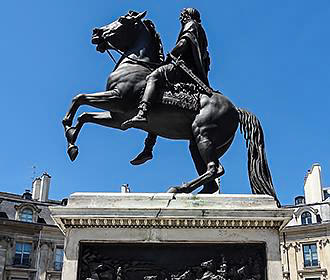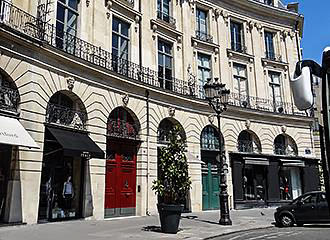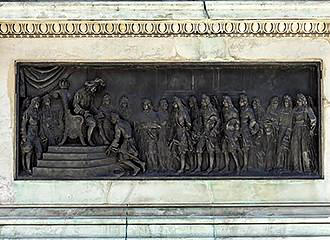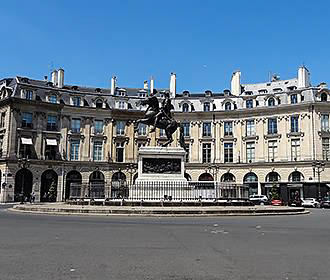Place des Victoires in Paris
Located on the border of the 1st and 2nd Arrondissements of Paris, the Place des Victoires was the first circular place of its kind and it was built around a statue in honour of King Louis XIV.
History of Place des Victoires
It was after the Treaties of Nijmegan that a Marshal of France by the name of Francois Feuillade, had the original buildings in this area destroyed, however his project for the reconstruction of the area was taken over and the design was of the buildings was entrusted to the kings chief architect Jules Hardouin Mansart.
The idea was to build large private houses that were like majestic private palaces and these were to all go round in a circle encompassing a statue that would commemorate the victories of King Louis XIV.
In fact, Jules Hardouin Mansart designed many different buildings such as the Grand Trianon and the Hall of Mirrors at the Chateau Versailles along with the Saint Louis church at Les Invalides and the buildings of Place Vendome.
The design that he came up with in 1685 was to have all the buildings with uniformed facades incorporating colossal pilasters that linked the two floors on an arcaded base. And when it came to the sloping roofs they would also have dormers, just like those in Place Vendome and these would all look over the statue of King Louis XIV in the middle of the Place des Victoires, which was the name chosen for this landmark in Paris and its central monument.
Now, the original sculpture was produced by Martin van den Baugart, who was known in France as Martin Desjardins, and he also produced works for the church at Les Invalides and for the Chateau Versailles castle. Plus some of his sculptures can still be seen today in the Musee du Louvre, which of course is the most famous of all the museums in Paris.
The gilt bronze statue designed by Martin Desjardins celebrated the early victories of King Louis XIV and depicted the king above the bronze captive figures from the different countries that France had gained victory over.
The statue was unveiled even before the Place des Victoires was completed and by 1692 there were six different streets that would interest the so called square, where the statue stood, but the circular plan actually made this easier to harmonise the different intersections.
However, King Louis XIV eventually left the city of Paris and over time with some humiliating military defeats and what the statue depicted, King Louis XIV began to get embarrassed by the statue, and many have suggested that this may of also provoked war with France.
Over time, the buildings in this circular area were completed and the statue remained in place, that is, until the French Revolution when the equestrian statue of the king was destroyed, however the captives remained and these are now preserved at The Louvre museum, and a marble copy of the statue can be seen at the Orangerie at Chateau Versailles.
But after the French revolution a wooden pyramid was positioned where the statue had originally stood, and in 1810 a statue of General Louis Charles-Antoine Desaix was put in place by Napoleon Bonaparte I.
Yet, even this statue did not last long, as after the defeat of Napoleon, this statue was also removed and it was melted down and this was then used to create a statue of King Henry IV at the Pont Neuf bridge that goes over the River Seine.
But only a few years later under the reign of King Charles X, a new statue of King Louis XIV was commissioned and sculpted by Francois Joseph Bosio, who had also created bas reliefs for the Colonne Vendome and the quadriga for the Arc de Triomphe du Carrousel along with a statue of King Louis XIV that is now located at the Chapelle Expiatoire.
The statue itself is around 12 metres high and depicts King Louis XIV dressed as a Roman Emperor who sits proudly on a horse that is rearing, and this statue was inaugurated in the year 1828.
Unfortunately some of the original buildings were destroyed by fire and when roads were widened, however, the Place des Victoires in Paris still has this same statue dating from the 1820s on a circular platform with wrought iron railings around it.
Yet the Place des Victoires, or Victory Square, still exudes that elegance and importance as it would have back then, and it is now home to many fashion boutiques and sumptuous private palatial houses, along with this monument in Paris that remains in a circle in the centre.
Access to Place des Victoires
When it comes to getting to this historical square via public transport, you will find that there are many different options all within walking distance including several Metro stations.
To start with via Metro you have the Bourse stop and the Sentier stop both serving Line 3. Then you have the Etienne Marcel stop serving Line 4 and the Pyramides stop serving Lines 7 and 14. In addition to these you have the Palais Royal - Louvre stop serving Lines 1 and 7.
As for the buses in Paris you have the Bus Lines 29, 48, 67, 74 and 85, along with the Noctilien Night Bus Service via lines N15 and N16, which takes over during the early hours when the normal buses and the Metro are not running, plus there is a Velib station for the self service bike hire scheme located only a short walk away on the Rue d'Aboukir.



